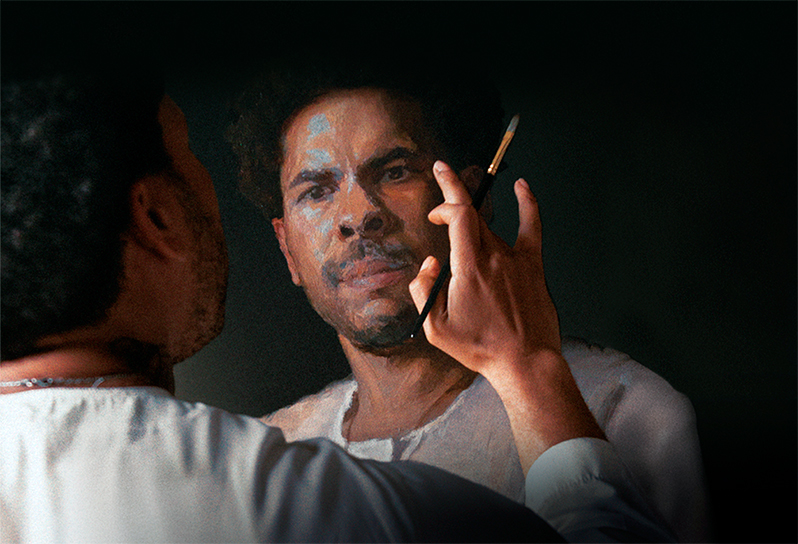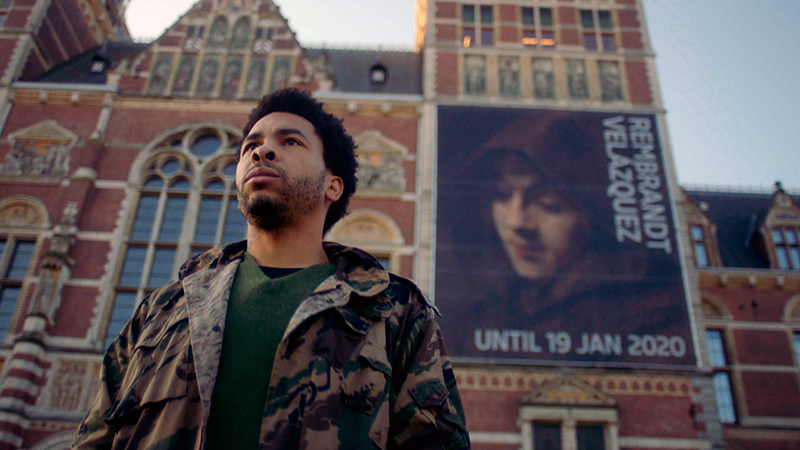
His portraits have been compared to Rembrandt’s and have been written up in The New York Times and earned him an invitation for a private up-close viewing of Rembrandt’s The Night Watchman at the Rijksmuseum in Amsterdam. But classical painter and Kansas City native George Anthony Morton’s life could not have been more different than the 17th-century Dutch master.
Morton’s mother was 15 when he was born. In the mesmerizing documentary Master of Light, as Morton is painting his mother, she tells him, “You were very planned. I wanted somebody who would love me.” The film, which debuted at SXSW in 2022 and can be streamed on HBO, traces the unlikely journey from juvenile detention to elite art circles.
Morton was the oldest of 11 siblings. His mother used and sold drugs, and the family moved so often they didn’t even have a neighborhood to call home. Morton was in and out of group homes and foster homes when his mother was incarcerated. He dropped out of school in 7th grade, and at 19 he was sentenced to 11 years in federal penitentiary, where he spent his time learning to paint in the style of the European masters, particularly his favorite, Rembrandt.
After his release, he was accepted into the Florence Academy of Art, where he became the first Black graduate of the prestigious academy and won its competition for Best Figure Drawing in 2015 and Best Portrait Drawing in 2016. His art was exhibited in a group show, Marking Time, at Metropolitan Museum of Art PS1 in New York.
Morton lives with his daughter Nuri, 9, in Atlanta, where he has a studio. His art can be seen at georgeamorton.com and @georgeanthonymorton on Instagram. He spoke by phone with IN Kansas City about his fractured yet tender relationship with his mother, his affinity for a 17th-century Dutch painter, and his spiritual connection to ancient Egypt.
When did you first see a Rembrandt painting?
When I was 15, I was in a juvenile facility in Kansas City. In the process of studying for my GED, I met a teacher who saw something in me because I would win art awards there, I would make all the monthly bulletin boards. She told me that when I got out she wanted to take me to the Nelson-Atkins. And she actually did it.
So, we go to the Nelson and I see this Rembrandt [Young Man in a Black Beret], and it stops me in my tracks. She tried to make me stop at a Renoir. She wanted me to study French art. She had me looking at the Impressionists, but when I saw that Rembrandt portrait, it stuck with me.
Then she would leave me, take me back to my environment that was pretty hopeless and that had a gravitational pull on me that was a lot stronger than the museum.
The film opens with a close-up of you cutting a powdery substance with a knife, then pushing it into a line. The viewer thinks drugs, but you are mixing oil paint. Is making the paint important to you or is it just a necessary step?
It’s not even necessary. Most of us get everything we want in our packages presented to us at art stores in tubes. But there was a time when Rembrandt had to make his own paint and prepare his own surfaces, and I was fortunate enough to receive that level of training and study Rembrandt’s processes. White lead paint represents everything we use to create light on a canvas. So, it’s important to me, because I like alchemy and having control over my creative process.
In one scene you say, “I want to be more light, less serious.” What does light mean to you as a state of mind?
It’s about being more light-hearted, but it also gets to the dualistic nature of our being. Even in the word “individual” is the word “dual.” So we put emphasis on the light. Most of us aren’t as complete as individuals as those who have experienced the shadowy parts.
In the film, we learn that for a long time you believed that your mother inadvertently got you arrested by bringing an informant around. Later some of your siblings told you she intentionally turned you in to get out of a charge she was facing. That’s the darkest thing I can imagine. How do you wrestle with that?
[Pause] The Biblical story of Joseph is how I see my mother, and it applies to Africa as well. When you look at the betrayal that happened historically, how Black people have been shipped all over the world, and if you ever go to Africa you see that it took other Africans to participate in that. It’s a sobering reality. You go to this utopia and see ground zero and how it happened, and these stories take on different a meaning, and you begin to try to see the beauty that can be in them. You begin to try to approach things without judgment.
In the film, you say your mom denies betraying you and you just want to believe her.
At the end of the day we’ve reconciled that. The conclusion we’ve come to, we’re happy with it. The broader point is that she freed me from an even bigger prison.
How so?
To go to the Federal Bureau of Prisons is my rite of passage as a young Black male growing up in America, in Kansas City, Missouri, to be exact. It was an escape from mental hopelessness and bondage in Kansas City, so that I see federal prison as an opportunity that was brilliantly disguised as a setback. And I see what she did for me as a favor and, like Joseph, I would be able to come back and save my siblings, my family and help everyone.

Why do you think you were able to find such deep compassion?
She taught me everything. She taught me everything. And I value what seemed like dark experiences that came as a result of her traumas, her dark experiences. I appreciate the pressure that has made a diamond. I appreciate the beauty that can be found in struggle. There’s something to be said about sublime qualities that can only be extracted out of us through difficulty. It seems that everything in life worth having has this price tag of difficulty attached to it.
Oftentimes I meet people who haven’t been through much and therefore don’t know themselves well enough, don’t have much to say or much to offer. I just began to try to look for the good in what seemed like a bad situation, and maybe it was crazy, maybe it was delusional to think that I could somehow go to prison, whatever got me there, and maybe make a career as an artist. I dared to do the impossible, and all I used were the things my mom taught me and the things my grandma, who died from an overdose, taught me, the very things that I learned in places that people in my life today would never probably want to be.
Was there a person who helped you in your art studies in prison?
I knew right away what I was going to prison to master. While still in the holding facility I was already making pictures, and all the letters I was writing to people, I told them what I would do while I was away and that’s just what I did. So by the time I got to Leavenworth I had it all mapped out.
When you first get there, if you’re not like a child molester or you don’t have a bad history, people from where you’re from or people who do what you do will try to help you. Especially when you go in at 19 or 20 and the men you’re around have sons your age who they can’t see. It’s really tough on them, so I had a lot of dads in there, I’d say that. Dudes would fight over who got to mentor me, because I was hungry for knowledge and love.
So the first thing I did was go to what we call the hobby crafts room, and there were a few political prisoners who spent their time in there, and there was this one guy who looked like a Hispanic, and he was painting wildlife animals and people with feathers in their head, and I quickly realized he was Native American, and I was just asking him about how to get my stuff to start. He was the first person to give me some old brushes, a palette, and some paints and an old canvas, and then it prompted one of the Black guys, and then a white guy helped me. They were all political prisoner types and really good guys. I didn’t know who Leonard Pelletier was at the time, but I’ll never forget that he was the first guy that gave me those brushes. I would later come down to our unit and see him in the day room in his chair waiting to go paint—we didn’t watch a lot of TV, those of us that painted. But one night A&E comes on and his case comes on the screen and he just gets up and walks away. He never talked about it.
What is your relationship to Kansas City now that you live in Atlanta?
My whole life, my roots, everything is Kansas City. That’s my America. That’s the story I want to tell. I’m proudly shifting out of studying and maybe even mimicking a European aesthetic and coming into my own American aesthetic. Kansas City is what feeds my crown.
The thing about Atlanta is it goes to America’s history. The farther south you go the more you’re dealing with the history of this country, which is for me an emotional source of creativity, around my own family’s migration in Kansas City.
I am proud of my hometown, but it’s a matter of going away so that I can come back and bring things back. I travel the world. I lead tours through the pyramids. I walk the cobblestones of Michelangelo and all the best Renaissance artists. I just took Nuri to North Africa for the winter solstice this past Christmas. She’s writing her book about these experiences. I’m currently sculpting the head of Osiris on the West Bank on a 25th Dynasty tomb, doing master copies on that level—things Rembrandt himself would give a limb to do.
Why do you lead annual tours to the pyramids?
My belief is that Egypt can only talk through the arts. It’s the source of the Renaissance. The North African Moors point you to Egypt. All the Golden Ages point you to Egypt. To understand it takes a right-brained person with an understanding of architecture and art, and that is what I studied.
My students in my atelier go with me. I share information about my trips every year in a private email blast to people who follow me and subscribe. I always go during the most auspicious times where it’s the most spiritual and not high tourist season. We get a boat. We sail the Nile. We get private exclusive access. They love me there because I bring groups.
And you get there, and you realize it’s not the terrorist threat that you thought if you’re watching CNN. You realize they’re still stumbling on new discoveries, because they have 7,000 years of recorded history and we have about 400. Art is magic, and this is the most magical place. This is where art began, and you see the original sacred use of it. We’ve gotten so far away from art as a sacred practice. So I go to these sacred places that still carry sacred energy, and I study there. It’s where da Vinci would have gone and studied, and there’s evidence that he did. All of this is encoded in Renaissance art. It’s encoded in Golden Age art. It all points you there if you know how to interpret it.
Do you ever step back and wonder how you got to this place where you get to sail down the Nile and get lifted up on a scaffolding to see The Night Watchman at the Rijksmuseum so close that you can sniff the paint?
It’s because my mother taught me how to fish in the dark. She is Isis. She is the real Isis. She is the real Hathor. She is the Great Mother. That symbol of fertility and fecundity. I go abroad and study Nut on the ceilings of the temples and see her. I see stars as her body outstretched and covering everything.
Interview condensed and minimally edited for clarity.


